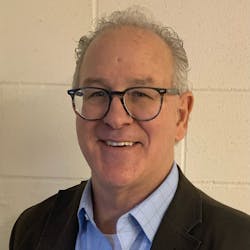SLC 2023 Preview: The Day Everything Changed
Life can change in a moment. That was the case for Greg Pass, who earned his bachelor’s degree in education but found himself working in safety and human resources a few years after graduation.
After about a decade in safety, Pass experienced a workplace tragedy. It’s been nearly 30 years, but he still remembers having to deliver the news to the family and the family’s lawyer who said, “You helped kill this boy” during a deposition.
That fatality renewed Pass’ commitment to safety, and he’s learned that sharing his story may just be the key to helping prevent future workplace tragedies. Pass is the director of safety for the YKK Corporation of America, a manufacturer of zippers and other fastening products. He will share his experiences and what he’s learned about the power of storytelling at the Safety leadership Conference, which will be held September 18-20 in Orlando, Florida.
More information about the conference, including registration, can be found at www.safetyleadershipconference.com. Below is a preview of what to expect from Pass’ presentation.
Pass: There are several things that have impacted my career regarding this fatality. After the fatality, I had to reexamine my career path, asking if I was cut out to be a safety professional. I decided I was—and that I would never lose another employee.
As I moved forward, I decided to make changes within myself. I needed to get out of the office and spend time with employees to obtain a better understanding of the risk the employees are exposed to. Then, I developed programs that addressed those risks.
But the most impactful was the day of the accident, when the president of the company and I went tell the young man’s parents that their son had fallen into the river, and we had not located him. I will never forget the hurt and pain on their faces.
You shared that not a day goes by that you don't think of that young man. Do you recall what happened in the days and weeks after that tragedy? Did that fatality prompt changes at the organization?
The search and recovery teams, the Coast Guard as well as the company continued to search for his body, but they called the search off after a few weeks. It was very hard on the family to not have his body to be able to hold a funeral, but they did hold a memorial service for him. The vice president and I attended the memorial service as representatives of the company. It was an extremely uncomfortable situation. There were stares and whispers when we walked into the service. But that was nothing compared to what his parents were going through.
The body was located approximately six months later, 100 miles down the river from where the accident occurred. I will go into much more detail during my presentation at the Safety Leadership Conference.
Most of the changes happened within me. I had to make safety my profession and not just a job. I needed to make a difference. I determined that in addition to following up on safety practices and near miss programs, spending more time with employees was the key prevent this from ever happening again.
Unfortunately, it can often take a tragic accident to open people's eyes and for change to happen. What advice do you have for safety professionals who wish to prevent injuries and proactively affect change?
Safety professionals need to spend much of their time with employees, building trust and transparency, learning about the job tasks that employees perform, and the risks associated with the job. In addition, we must realize that as safety professionals, we are not the safety program; the program belongs to the employees.
We are the resources for them. We direct compliance initiatives through regulatory requirements. We develop the written policies, procedures and training programs. But the employees make it all happen, and they need to be a part of this process to improve workplace safety.
Why do you think it's important for other safety professionals to speak up about workplace fatalities, injuries and even near misses?
Because it could prevent injuries or fatalities. Currently, I oversee 14 locations in the United States and other countries, and we have meetings quarterly to discuss all near misses and accidents. They are reported to me as they occur. Safety is about reducing risk; this helps reduce similar risk at all our locations.
You mentioned that you sometimes share your experience during on-site training. How do employees react? What do they tell you after?
It is emotional for me to discuss. I believe the group can feel the passion for why I tell this part of my life. My audience is usually quiet when I share about the fatality. Many express their apologies that I had to experience this. I think telling my story makes workplace fatalities seem like a potential reality to others, rather than just a possibility.
What has been one unexpected outcome as the result of sharing your story with others, either something you've experienced or something you've heard from others?
When conducting training with adults, we always question how much they learn and retain, but there have been many employees who have mentioned the fatality to me throughout the years. It’s clear they remembered my training session. That’s why I feel like I need to tell it. Sharing my experiences could save someone’s life or prevent a serious injury. If I can help someone avoid my mistakes or what that family went through all those years ago, then it’s worth it.
Based on your own experiences, what is the power of storytelling? What is the power that comes from opening up and being vulnerable?
Storytelling is powerful if it inspires people to examine their own self, their practices and beliefs, and make improvements in their lives. I realized there is a difference between “having a job in safety” and becoming a safety professional.
We spend a lot of time talking about our success but not a lot of time talking about our failures or shortcomings. What message do you want to communicate with safety professionals who have experienced the loss or injury of one of their employees?
Safety professionals take any injury personally, sometimes to the point of blaming themselves. We need to learn from any accident, review all safety programs and training to determine if anything was missing in the overall safety program. We shouldn’t wallow or continue to blame ourselves. We need to take action to prevent future injury.
We must communicate with senior management, fight to get on meeting agendas and communicate the good things going on in safety. Senior management usually just hears the bad things that happen, but we need to communicate our value and our successes. The best way to do that is by spending time with employees. Listen to them. Let them know they are heard.
What's one thing you hope attendees learn from your session at the Safety Leadership Conference?
A fatality can happen in the blink of an eye. We all have learned that in our personal and professional lives. Accidents affect many people, and the families are the ones impacted the most. I often wonder about the family that lost the young man that I’m speaking about, how they have coped through the years.
I want attendees to feel empowered to act so they don’t have to bear a similar burden. It will be 30 years in December, but that fatality seems like yesterday.
About the Author
Nicole Stempak
Nicole Stempak is managing editor of EHS Today and conference content manager of the Safety Leadership Conference.


